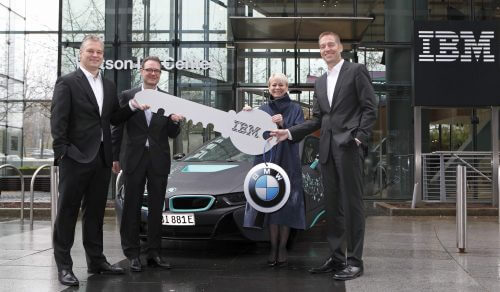The two companies will begin joint research to teach cars the preferences and habits of the driver to improve the driving experience. Among other things, information about the weather, traffic updates and the condition of the vehicle will be integrated

IBM and BMW will cooperate in the application of IBM's cognitive computing capabilities (Watson) in vehicles, with the aim of offering a personalized driving experience and producing intuitive support systems in BMW's future cars. As part of the agreement, a BMW research group will be located at IBM's global IoT headquarters in Munich. Together the two giants will work to improve smart functions for BMW cars.
Watson's Machine Learning capabilities will allow vehicles to learn drivers' preferences, their needs, their driving habits and will adapt a personal driving experience to each and every driver, while improving driving comfort and safety. Implementing the Watson system in cars will allow the driver to ask the car questions in normal speech, while his eyes continue to focus on the road ahead. The new solution will also integrate information from IBM's Weather Company in real time including: updates regarding the road, the weather, the traffic situation and the condition of the vehicle, in order to enrich the driving experience and provide the driver with relevant recommendations.
According to Eitan Hadar from IBM's research laboratory in Haifa: "Combining artificial intelligence and machine learning together with a variety of information sources will provide us with a sensory experience while driving the likes of which we have not known until today. including the experience of all the passengers in the car. The smart systems will respond to our various needs in our day-to-day life in a holistic way and will increase our safety on the road."
To promote its automotive research and demonstrate the capabilities of Watson IoT technologies to its customers, IBM will place four BMW i8 hybrid sports cars at the Watson IoT headquarters in Munich. This is a prototype for cognitive solutions that will run on IBM's Bluemix cloud platform and help demonstrate how Watson enables new conversational interfaces between cars and drivers.
Not long ago, IBM announced that it would invest 200 million dollars in its collaborative research center in Munich. BMW, whose headquarters are also located in the Bavarian capital, is one of the first companies to sign a cooperation agreement that includes the location of its development team within the Watson Internet of Things application headquarters building. Researchers, developers and consultants of the two companies will work together to examine the place of advanced technologies in strengthening the emotional and cognitive connection between cars - and between their drivers. More than 6,000 companies worldwide are already using Watson technologies for the Internet of Things. IBM is currently in talks with a number of other customers in order to connect more than a quarter of a million different devices to Watson's cloud platform.
According to IBM research, there are a number of trends that currently characterize the automotive world and the relationship between cars and humans: vehicles that are able to diagnose and repair themselves and even help repair other vehicles, without human contact. Vehicles that know how to connect to other vehicles and the world around them. Cars with cognitive ability to continuously learn the behavior of the driver, passengers and other vehicles and provide advice based on the information. In addition, vehicles today are becoming more and more autonomous, they know how to adapt to the personal preferences of the driver, from adjusting the height of the seat to identifying and locating the driver's preferred destinations. The vehicles also know how to integrate with other smart devices, becoming part of the IoT trend while connecting to traffic, weather and events related to the mobile world happening around.
